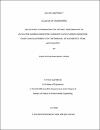Graphene/TiO2 composite electrode: Synthesis and application towards the oxygen reduction reaction
View/
Date
2014Author
Al-Kandari, Halema AliAbdullah, Aboubakr Moustafa
Mohamed, Ahmed meslam
Al-Kandari, Shikah Ali
Metadata
Show full item recordAbstract
A graphene oxide (GO) was prepared from a commercial graphite nano-crystals using Hummers’ method. Later, GO powder was reduced either by placing it under a H2 gas flow in a controlled gas reactor at 450 oC or using a hydrazine hydrate solution (HH) in a 1000-Watt microwave oven. X-ray photoelectron spectroscopy (XPS) and X-ray diffraction patterns (XRD) confirmed that both of the oxidation and reduction processes of graphite and GO powders, respectively, were incomplete. Also, the surface area of the H2 gas - reduced GO powder was found to be higher than the case where HH was used to reduce the same powder. Fourier transform infrared spectroscopy (FT-IR) and XPS have revealed that GO surface consists mainly of hydroxyl, epoxy, carbonyl and carboxylic groups. The electrocatalytic properties of (i) glassy carbon (GC), (ii) commercial TiO2 (P25-TiO2/GC), (iii) TiO2-supported GO (GO/TiO2/GC), (iv) TiO2 – supported HH – reduced GO (HHRGO/TiO2/GC) and (v) TiO2 – supported H2 gas – reduced GO (H2RGO/TiO2/GC) electrodes towards the oxygen reduction reaction (ORR) in acidic solution in presence and absence of UV radiation were examined. The results have shown that the H2RGO/TiO2/GC electrode has the best electrocatalytic activity in terms of current at a certain potential but glassy carbon electrode (GC) was found to be the best in terms of the onset potential of the ORR.
Collections
- Center for Advanced Materials Research [1647 items ]
Related items
Showing items related by title, author, creator and subject.
-
Developing a Framework for Optimal Performance of Activated Carbon/ Graphene Oxide/Activated Carbon-Graphene Oxide Nano Adsorbent for the Removal of Antibiotics from Wastewater
Varde, Sunita Roshankumar (2021 , Master Thesis)Antibiotics are important drugs for treating infectious diseases and they have undoubtedly saved the lives of millions of people. A growing global problem is the emergence of antibiotic resistance, which means that the ... -
Heterogeneities in Polymer Structural and Dynamic Properties in Graphene and Graphene Oxide Nanocomposites: Molecular Dynamics Simulations
Azimim, Majid; Mirjavadi, Seyed Sajad; Hamouda, Abdel Magid Salem; Makki, Hesam ( Wiley-VCH Verlag , 2017 , Article)The effect of graphene (G) and graphene oxide (GO), used as the nanofiller in polymer nanocomposites (NC), on the structural and dynamic properties of polymer chains, has been studied by means of molecular dynamics (MD) ... -
Effect of the graphene oxide reduction method on the photocatalytic and electrocatalytic activities of reduced graphene oxide/TiO2 composite
Al-Kandari, H.; Abdullah, A.M.; Al-Kandari, S.; Mohamed, A.M. ( Royal Society of Chemistry , 2015 , Article)Graphene oxide (GO) was synthesized from commercial graphite using a modified Hummers' method. Three different methods were used to prepare reduced GO/TiO2 composites. GO was (i) initially impregnated over TiO2 (GOTi) and ...


